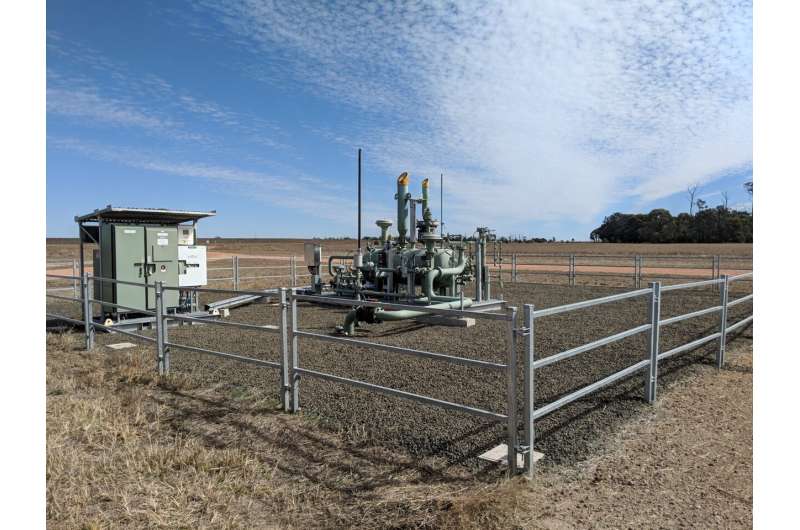This article has been reviewed according to Science X's editorial process and policies. Editors have highlighted the following attributes while ensuring the content's credibility:
fact-checked
trusted source
proofread
Research explores influence of coal seam gas activity on human health

New research has been released into the potential for coal seam gas (CSG) activity in Queensland to affect human health.
A 2,150-square-kilometers study site in the Surat Basin, Queensland, was selected and factors that could lead to potential hazards such as chemicals, air emissions, noise, light and dust associated with CSG activities were identified and appraised. Existing data related to these factors was screened to determine whether any factors would require in-depth assessment.
While the study found that for the majority of factors there was no plausible pathway to impact human health, it determined further in-depth assessment of a small number of identified factors was required.
As a result, two new CSIRO research projects are now underway and will conduct further in-depth studies focusing on eight groups of chemical factors.
The research, undertaken by CSIRO and The University of Queensland, was governed through CSIRO's Gas Industry Social and Environmental Research Alliance (GISERA). GISERA is an alliance led by CSIRO and is a collaboration between CSIRO, commonwealth, state and territory governments and industry with the purpose of working with the community to undertake research about the potential or actual impacts of gas development, across major environmental and socio-economic topics.
CSIRO Energy Resources Research Director and GISERA Director Dr. Damian Barrett said the study provided forensic information about the potential hazards to affect human health from CSG activities in the Surat Basin.
"The value of this exhaustive study is that it provides certainty about where we need to focus further research," Dr. Barrett said.
"By ruling out factors of no concern we ensure cost-effective and targeted use of research resources to zero in on chemical factors with a possible pathway for potential impact on human health.
"CSIRO is already taking the next steps to look more closely at these eight groups of chemical factors where a potential pathway can't be ruled out or more information is needed."
Study overview
The study examined all activities relating to coal seam gas operations in a 2,150 square kilometers study in the region of Miles, Chinchilla and Condamine. CSG infrastructure in the study area comprised more than 2,400 wells, 5,000km of gathering lines, four water treatment plants, eight gas processing plants, and 15 compression stations.
Researchers identified "factors" associated with CSG activities within the study site and appraised them for their hazard potential to human health. These factors included chemicals (chemicals used by industry and naturally occurring chemicals that may be released by industry activities), air emissions, noise, light and dust.
The university's Queensland Alliance for Environmental Health Science (QAEHS) appraised the chemical factors used by industry, while CSIRO completed the assessment of chemical factors associated with air emissions and physical factors (noise, light and dust).
Australia Pacific LNG's upstream operator Origin, and Shell's operator QGC supplied data on their activities. Researchers also accessed Queensland Government data sets. This information related to drilling and workovers operations for 2,424 wells, detailed data for the 67 wells in the study area that were subjected to hydraulic fracturing, and data relating to water treatment, gas processing, and flaring operations.
In addition to CSIRO and GISERA's existing governance arrangements the health study was subject to additional governance and ethics controls, and was supported by local regional stakeholder and technical reference groups.
The health study design was based on a framework developed by CSIRO in a previous related GISERA health project that closely follows the established enHealth Health Impact Assessment approach.
Key results
The study found that for the majority of factors, there was no plausible pathway to impact human health. Noise and light emissions from CSG activities do not pose a hazard to physical health in the study site. Chemical factors associated with air emissions from CSG activities were within relevant health-based air quality objectives.
Of the 97 unique chemical factors used in CSG drilling and hydraulic fracturing operations:
- 72 were assessed and found to have low hazard potential to human health at the study site.
- 25 chemical factors (in eight groups) warrant further in-depth assessment. Based on the available evidence, none of these chemicals were found to represent an acute hazard to human health in the study site.
- A CSIRO extension study examined the microbial degradation of these groups of chemical factors in soil and aquifer samples and found that four chemical groups degraded readily in soils within days, and more slowly in aquifer samples.
Further research
In response to this study two new CSIRO research projects are underway and will conduct further in-depth studies focussing on these eight groups of chemical factors.
One of the newly approved studies—Exposure assessment of identified chemicals used in CSG activities—will examine the seven chemical groups that have a potential pathway to affect human health via soils and groundwater. The other study—Analysis of dust near CSG sites to assess potential for respirable crystalline silica—will focus on the eighth chemical factor, silica dust, which has a potential airborne pathway to affect human health. Both new studies will involve comprehensive field sampling campaigns.
More information: The report is available online: gisera.csiro.au/wp-content/upl … -Synthesis-Final.pdf
Provided by CSIRO



















